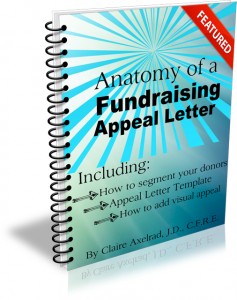I decided to write this post due to the number of times nonprofits ask me “How often should we mail to our donors?” The corollary question is “How often can we ask people to give?”
The answer?
Well… if there was one quick answer I wouldn’t have needed to write a whole article. I’d just have given you a headline with a definitive response!
I know you want a definite answer.
And I could give you one. But it wouldn’t be the truth. Because the truth is different for every nonprofit. And the truth will even be different for your nonprofit at different points in your life cycle.
There are two definitive things I can tell you:
- You are not your donors, and
- Your donors lie.
You are not your donors.
Have you ever written a fundraising appeal “by the book,” only to have your Executive Director or your Board President tell you they would never respond to it? I hope you know by now that when it comes to crafting your direct mail appeal, whatever you hate is probably exactly the right thing to send to your donor prospects.
- Because your donors don’t live and breathe your cause the way you do.
- Because your donors don’t speak in jargon the way you do.
- Because your donors need to be sold on things you already believe.
- Because your donors have a lot of causes competing for their attention, and you aren’t already at the top of their list.
Have you ever had your board urge you to change your branding or advertising because they’re “tired” of it? I hope you know by now that your target audiences tire of things far less quickly than do you.
- Because, again, your donors don’t live and breathe your cause.
- Because your donors don’t see your brand or your ads every minute of every day.
Your donors lie.
Sometimes organizations will survey their donors and ask them how often they’d like to be approached. Most people will predictably say once a year. This is a great way to lose your donors. Why?
- Because how people say they’ll behave is often quite different from the way they’ll actually behave.
Years ago there was a famous door-to-door study where survey researchers knocked on people’s doors and asked them what magazines they read. Wanting to look “smart” people answered with things like “Time” and “Life” and “The New Yorker.” Then researchers looked in their trash cans. They found all sorts of “junk” and “gossip” literature that none of the respondents mentioned.
How to Determine How Often to Mail
The only way you can determine how your donors will behave is to experience it. And this means testing.
You can look at tests done by other organizations as a starting point. And we do know that large organizations who’ve done this testing are now mailing monthly, with 3 – 4 emails in between! Is this right for you? The only way to know is to test it for yourself. However, it’s not a bad place to begin.
Donors who give to large organizations are often the very same prospects you are hoping to reach. They are used to hearing from the nonprofits they support on a consistent basis. So how are you going to compete for their attention?
Remember, you can always offer folks the option of unsubscribing from your mailings. When you comply with this request, you score points for doing what you say you do. This builds trust. And the reality is that very few folks will decide to unsubscribe.
People may not read every mailing you send, but this doesn’t mean they don’t like receiving them. In a way, it reassures them that you’re still a healthy, vibrant organization that’s out there in the community doing good things.
If you stop mailing, people are left to draw their own conclusions.
The Best Time to Mail Again is Right Away
Donors who make their first gift are testing you. They’re waiting to see how much you’ll value their support and whether you’ll deliver on your ‘promise’ to make effective use of their gift. They need to be reassured, right away, that they made a good decision.
What, How and Who you Mail to Matters
In fact, it matters as much, or more, than how often you mail.
Instead of trying to find excuses to communicate with folks less, how about finding ways to communicate more effectively?
Many times when people ask me how often they should mail and ask for donations they’re really asking why they aren’t raising more money. Are they offending folks by sending too many mailings? Are they pussyfooting around by not sending enough? Often, those are the wrong questions.
Because as soon as I take a look at their appeal… or as soon as I ask them who is on their mailing list… or as soon as I ask them what other communication channels they are using to leverage greater support… I can tell why they aren’t generating larger returns.
- If your mailings are institution-centered (all about you and how great you are) you’re not going to achieve the results you’ll get if you make your appeal donor-centered (all about your donor and how they can be a hero by investing with your cause).
- If your mailings are generic, and you’re not using segmentation to send the most personal, relevant appeals possible, then your appeal is not going to be as engaging as it needs to be.
- If you’re sending snail mail to people whose primary means of communication is email or social media you’re not maximizing your chances for success. Especially if you’re targeting younger donors, an approach through social media using peer influence may work better.
- If you don’t have the right people on your mailing list, you’re not going to have great chances to achieve your desired results. I’ve seen many wonderful fundraising appeals fail for want of a good mailing list.
Practical Advice for Mailings
More is usually more. I like to mail as often as I can afford to do so (taking into account both human and financial resources).
If you make more money with your mailing than it costs you, then why not?
If you think you should be netting an even larger profit, then it’s time to take a look at what you’re mailing, who you’re mailing to and how you’re getting your message across.
Quarterly mailings (not including newsletters) is just about the minimum I’d recommend for any nonprofit if you want to stay top-of-mind. And one or two emails monthly is certainly not out of bounds. As you expand services and need to raise more money, expanding the number of mailings you send makes a lot of sense.
Layering on social media to reinforce the message in your mailing is generally a good idea. Have you ever heard the maxim that someone needs to see an ad seven times before it sticks?
The Point of Your Mail Appeals
Remember, fundraising is not about money. It simply serves your end goal, making it possible to finance the programs and services upon which your community relies. Fundraising is your reward for being successful. For making a difference. Because if that’s the outcome your organization creates, then you’ve earned the right to raise funds.
Stop thinking of your appeals as begging. Do you feel joy when you give to your cause? Then start thinking of your appeals as announcements of opportunities to share your joy. As opportunities to share in your remarkable cause. Then turn your announcements into offers people simply cannot refuse!
Want to learn to create remarkable appeals?
Two opportunities await you:
- Grab my Anatomy of a Fundraising Appeal + Sample Template. It’s a simple, step-by-step guide to crafting a killer appeal letter. Get it here. Use it to tweak your year-end fundraising. Use it all year.
- Join me January 5 – 9 for The Fundraising Summit. I’ll be offering a free webinar: Anatomy of a Successful Fundraising Offer, plus you’ll find 40 other experts offering free webinars online on just about everything you can imagine to do with fundraising. All you have to do is register.
Now that’s something to be thankful for! Have a very happy holiday, and thank you for all you do to make our world a better, more caring place.








Hi Claire, great post.
I get asked this question all the time too.
I work with a lot of small to mid size organizations and I’ve ‘moved’ many of them to go to at least the 4 times a year which in my mind like yours is indeed the absolute minimum!!
And those organizations who have gone from once to twice to four times a year have absolutely seen their gross and net revenue grow by leaps and bounds.
Any less than 4 times a year, you’re leaving a lot of money on the table!! Yes, will you have some donors who complain, absolutely, but you can certainly send them less mail or better yet, convert them to a monthly giving program, no mail needed but revenue coming in!
Finally, if you’re familiar with James Greenfield chart about the cost to raise a dollar. Mailing to existing donors costs $0.20 to raise a dollar on average. That means you invest $1,000 and you get $5,000 back!! What’s not to like about that equation. You certainly will not get that anywhere in the stock market!
Thanks again for the great post, have a wonderful Thanksgiving! Cheers, Erica
Thanks so much for this Erica. I hope you’ve helped to emphasize for others some of the points I’ve tried to make. Yes, I’m familiar with the James Greenfield chart. Years ago I had the pleasure of attending the Executive Leadership Institute of the University of Indiana School of Philanthropy with Jim. He was kind enough to spend an hour with me one day teaching me how to calculate my cost of fundraising. I’ve used his methodology with great success ever after, and I encourage others to do so as well. It’s a great way to demonstrate to your leadership (staff and board) what makes sense and what doesn’t.
I think what you have to say about investing in fundraising speaks to the larger issue of investing in overhead as well. If you can spend another $1,000 to raise another $5,000, why wouldn’t you boost your overhead a bit to do so? We’ve got to figure out a way to stop promoting ridiculously low overhead as the main indicator of a nonprofit’s effectiveness. But I digress…
Hope you have a wonderful Thanksgiving as well. We should virtually meet one day!
Sound advice as always, and thank you for closing with a thank you, I really needed to hear that as I’m ramping up the appeals!